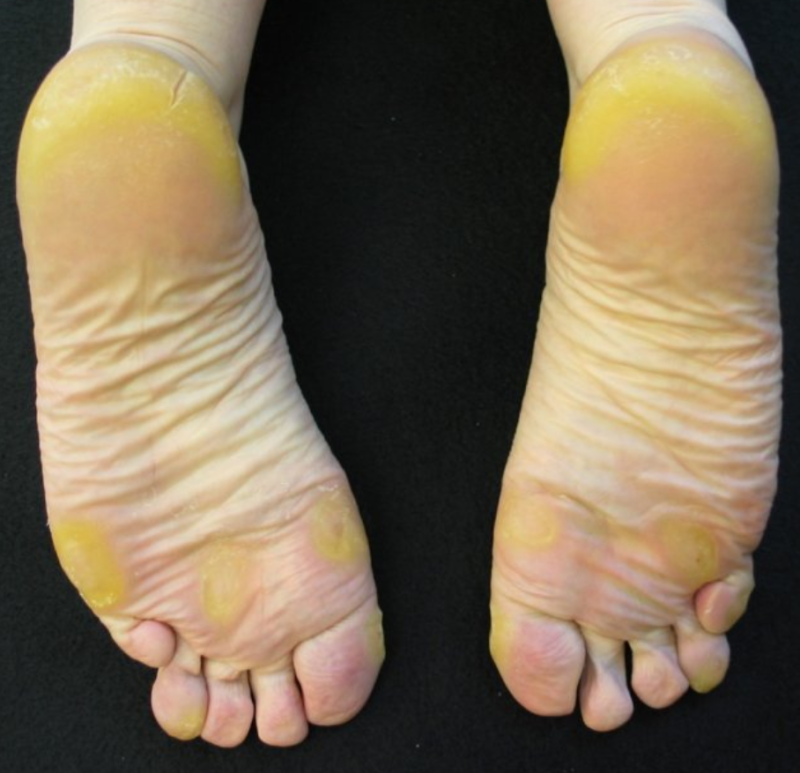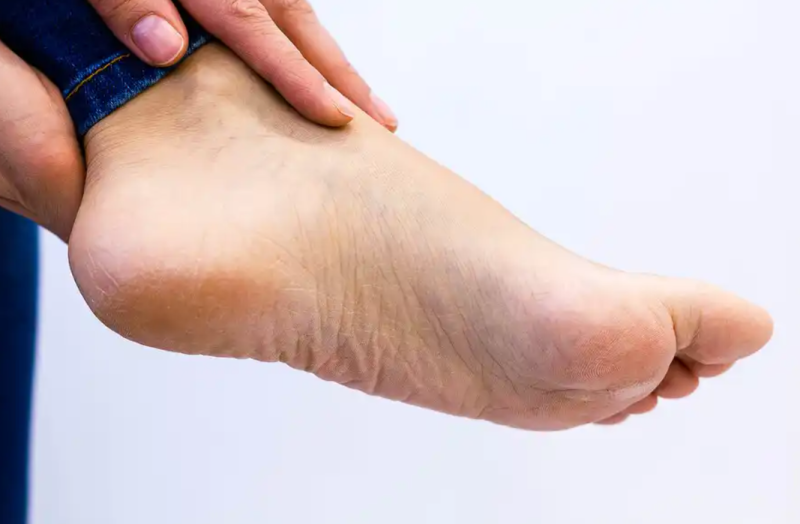
The soles of the feet are a part of the body that we barely pay attention to. However, they are an area that, like the palms of the hands, can reflect many processes or pathologies inside the body. In this sense, the soles of the feet can turn yellow for multiple reasons.
Color changes on the soles of the feet occur frequently due to numerous causes. People are often alarmed when they notice a yellowish coloration in this part. However, there is no reason to lose your cool; this change does not have to indicate something serious.
It is even expected that instead of appreciating it on our own feet, we observe it on those of the baby or our son. The usual thing is that the yellow soles of the feet are due to excess carotenes in the diet. Carotenes are pigments that are present in many foods, such as carrots.
Contents
Carotenoids and the soles of the feet
As we have already mentioned, the most frequent cause of yellowish soles of the feet is hypercarotinemia. It is a benign condition in which the person has excess carotenes in the body.
Carotenes are pigments found in many fruits and vegetables. They are usually the culprits that vegetables have that yellow or red color. For example, oranges, carrots, or sweet potatoes are rich in this substance.

Hypercarotinemia can be produced, in the first place, by ingesting a large amount of carotenoids. However, it is often associated with other diseases that cause this substance to increase in the blood. For example, it usually occurs in people with hypothyroidism.
It is a pathology that does not entail symptoms apart from the yellowish coloration we discuss. It usually affects the soles of the feet and hands without staining the mucous membranes or the sclera. It is something transitory that only affects an aesthetic level.
What other causes are there of having yellow soles?
In addition to hypercarotinemia, other situations can cause the soles of the feet to look yellow, and some of them are indeed pathological—for example, jaundice.
Jaundice is a medical term used to refer to the yellowing of the skin and mucous membranes when bilirubin is above average blood values. Bilirubin is a yellow pigment metabolized and excreted in the liver, which is why it acts as an indicator of the functioning of this organ.
When there is jaundice, not only the soles of the feet and the palms of the hands turn yellow, but also the eyes and mucous membranes. This pathology may be due to liver failure such as cirrhosis, hepatitis, or biliary colic, among other causes.
If what worries you is that it is your baby, you must know about newborn jaundice. This is a relatively common situation at these ages. It is usually temporary, but the idea is to consult with a pediatrician.
On the other hand, anemia can also cause this situation, although the coloration is not intense yellow but pale in this case. It consists of a decrease in red blood cells or hemoglobin concentration. There are usually other accompanying symptoms in these cases, such as tiredness and fatigue.

Other less frequent causes
Interestingly, certain poisons can cause the soles of the feet to be yellow. One of them is a chemical compound called trinitrotoluene (TNT). It is used in the industrial field, so it is rare for an average person to present it.
Like hypothyroidism, other diseases such as diabetes mellitus, some hereditary or metabolic conditions are also related. Other less frequent causes of discoloration of the soles of the feet include the following:
- Kidney failure is a reasonably severe pathology in which the kidneys stop working correctly. Symptoms, such as generalized edema and decreased urine output, accompany it.
- Fungal infection: Another cause of yellow soles can be a fungal infection, primarily if the coloration affects the nails. Dermatophytes are the most frequent causative agents; they can influence the skin’s keratin, causing abnormal coloration.
- Hyperlipoproteinemia – This is another way of referring to high cholesterol. Undecomposed fats accumulate in different body parts, especially in the skin, causing the affected area to turn yellow.
- Raynaud’s disease is a condition in which peripheral blood vessels contract excessively in response to stress or cold. This pathology should always be suspected when the soles of the feet turn white or yellow, then blue, and finally red after exposure to cold.
Remedies for yellow soles
If you notice a change in color on the soles of your feet, it is best to go to a specialist. The doctor will be able to identify the cause of the problem and start a specific treatment for each condition.
For their part, there are home remedies that, although they do not replace medical treatment, can help feet return to their standard color. Some of the tricks you can try to combat this problem are as follows:
- Bicarbonate or hydrogen peroxide: soaking the feet for at least 20 minutes in warm water with bicarbonate or hydrogen peroxide is beneficial. Both substances have whitening properties and are antiseptic, so they will help fight any infection.
- According to popular wisdom, placing mashed potatoes for a few minutes daily on your feet can help combat yellowing in the area.
- Lemon – Lemon is an excellent bleaching substance, so lemon juice can be applied two times a week. It will only be necessary not to sunbathe after it uses to avoid new spots.
It is always essential to consult your doctor.
Don’t be alarmed if you see that the soles of your feet or hands are yellow. The most normal thing is that it is due to hypercarotinemia that does not put your health at risk. However, it is essential that you still see a doctor to rule out any other cause.